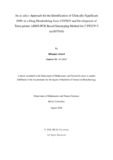An in silico approach for the identification of clinically significant SNPs in a Drug Metabolizing Gene CYP2C9 and development of Tetra-primer ARMS PCR based genotyping method for CYP2C9*3 (rs1057910)

View/Open
Date
2020-08Publisher
Brac UniversityAuthor
Ahmed, RifaquatMetadata
Show full item recordAbstract
The role of SNP is an important factor related to drug metabolism. The presence or absence of SNP can significantly alter the effect of the same amount of drug inside the body leading to various unwanted side-effects which can be harmful at times. The drug warfarin is one such drug that has a different effect based on the SNPs present inside the CYP2C9 gene metabolizing the drug. Various SNPs can be present at different positions in the CYP2C9 gene among which some of them can be in the active site which has a significant impact on drug metabolism. However, not all SNPs can have an effect on drug metabolism. As a result, bioinformatics tools were used in the study to identify the clinically significant SNPs from the CYP2C9 gene. Homology based modeling was used to model 3D proteins containing candidate SNPs which were docked with the ligand to be compared with positive control. The results showed data that could be used for comparison to know significant SNPs in the CYP2C9 gene. The CYP2C9*3 was found to be a clinically significant SNP that has a prevalence in the Bangladeshi population. Then, for the determination of the genotypes in the collected samples, a method was required for genotyping. There are various methods for genotyping of a SNP among which the tetra primer ARMS-PCR method was selected due to the process being inexpensive, time-efficient, and easy to perform in any diagnostic labs across the country. The primers were designed using a web-based primer designing tool and the PCR process was optimized for a successful PCR reaction. The optimization was successful which showed bands in the gel electrophoresis. However, due to the sample number being low, even though there were the bands for the outer primer and the band for wild type allele, no bands for mutant alleles were obtained. Thus, the prevalence of the mutant allele could not be confirmed. Further experimentation on more samples is required to obtain enough data to know the prevalence of mutant alleles in the population using the optimized PCR method.
